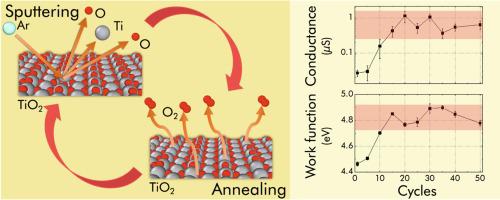Applied Surface Science ( IF 6.7 ) Pub Date : 2021-09-24 , DOI: 10.1016/j.apsusc.2021.151303 K. Cieślik 1 , D. Wrana 1 , K. Szajna 1 , W. Bełza 1 , M. Rogala 2 , C. Rodenbücher 3 , P. Dąbczyński 1 , K. Szot 4, 5 , F. Krok 1

|
Repeated sputtering and annealing are standard preparation methods for obtaining a stoichiometric TiO2(1 1 0) surface for surface science experiments. However, both processes result in a reduction in TiO2 crystal when used separately, leading to the modification of the physical and chemical properties of oxide materials. Our investigation aims to determine how these two processes affect the electronic properties of the surface and subsurface regions at the nanometer scale. To accomplish this goal, we utilized local microscopy (Kelvin probe force microscopy and local-conductivity atomic force microscopy) and spectroscopy methods (X-ray photoelectron spectroscopy and secondary ion mass spectrometry). We found that repeated sputtering and annealing does, in fact, affect both the conductivity and work function of the surface. The work function, as well as conductivity, increase with increasing number of cycles, but then reach a plateau. Furthermore, we show that the way the surface is prepared, using multiple cycles or one cycle of equivalent ion-beam fluence, matters. We attribute the differences in the crystal properties to the dynamics of stoichiometric changes during sputtering and subsequent annealing which we illustrate using secondary ion mass spectroscopy, which shows that after multiple cycles the subsurface layer is modified, even though XPS shows a stoichiometric surface.
中文翻译:

通过重复溅射和退火调整清洁 TiO2(1 1 0) 表面的电子特性:KPFM 和 LC-AFM 研究
重复溅射和退火是获得用于表面科学实验的化学计量 TiO 2 (1 1 0) 表面的标准制备方法。然而,这两个过程都会导致 TiO 2的减少晶体单独使用时,导致氧化物材料的物理和化学性质发生改变。我们的研究旨在确定这两个过程如何在纳米尺度上影响表面和亚表面区域的电子特性。为了实现这一目标,我们利用了局部显微镜(开尔文探针力显微镜和局部电导原子力显微镜)和光谱方法(X 射线光电子能谱和二次离子质谱)。我们发现,重复溅射和退火实际上会影响表面的电导率和功函数。功函数以及电导率随着循环次数的增加而增加,但随后会达到平稳状态。此外,我们展示了表面的制备方式,使用多个周期或一个周期的等效离子束注量,很重要。我们将晶体特性的差异归因于溅射和后续退火过程中化学计量变化的动力学,我们使用二次离子质谱法说明了这一点,这表明在多次循环后,次表面层发生了变化,即使 XPS 显示出化学计量表面。



























 京公网安备 11010802027423号
京公网安备 11010802027423号